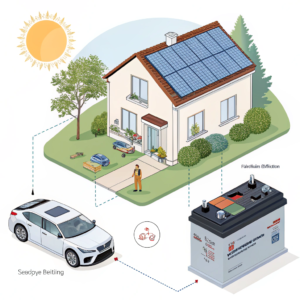Deep Analysis of Global Market Trends for Battery Energy Storage Cabinets
•
Deep Analysis of Global Market Trends for Battery Energy Storage Cabinets
Are power shortages and unstable grids holding back economic growth in developing regions? Battery energy storage cabinets[^1] might be the game-changing solution.
Battery energy storage cabinets[^1] stabilize grids, store renewable energy, and provide backup power, making them vital for addressing global energy challenges while supporting sustainable development goals.

The global energy storage market[^2] is undergoing rapid transformation. From Africa's power deficits to the Middle East's harsh climate demands, battery cabinets are emerging as critical infrastructure. Let's explore how these systems are shaping regional energy landscapes.
African Market: Energy Storage Cabinets Help Address Power Shortages and Unstable Power Supply Issues?
Why do 600 million Africans lack reliable electricity despite abundant solar resources?
Energy storage cabinets paired with solar/wind systems provide off-grid communities with stable power, reducing diesel dependence and enabling economic activities in remote areas.
The Energy Access Crisis and Storage Solutions
Africa's energy paradox:
- 58% of sub-Saharan Africa lacks electricity access (World Bank)
- Solar potential: 10x current energy demand if harnessed
| Application | Storage Benefit | Example Countries |
|---|---|---|
| Mini-grids | Smoothes solar/wind output | Kenya, Nigeria |
| Telecom towers | Replaces diesel generators | Tanzania, Ethiopia |
| Healthcare facilities | Ensures vaccine refrigeration | Mozambique, Malawi |
Key challenges:
- Financing: High upfront costs ($200-$400/kWh)
- Maintenance: Limited technical expertise
- Climate resilience: Battery performance in tropical climates
Recent success: South Africa's "Battery Box" program deployed 1,200 storage units to schools and clinics, reducing outages by 80%.
Rising Energy Storage Demand in the Middle East: System Design Challenges Under High-Temperature Conditions?
How do 50°C desert temperatures impact battery cabinet performance?
Middle Eastern installations require liquid-cooled lithium batteries[^3] and thermal management systems[^4] to maintain efficiency, with specialized designs adding 15-20% to project costs.
Engineering for Extreme Environments
Critical design considerations:
Material Selection:
- Aluminum cabinets (better heat dissipation than steel)
- Ceramic-coated battery cells
Thermal Management Comparison:
| Method | Pros | Cons |
|---|---|---|
| Air cooling | Low cost | Ineffective above 45°C |
| Liquid cooling | Precise temperature control | Higher maintenance |
| Phase-change materials | Passive operation | Limited market availability |
Case study: Dubai's 250MWh storage project uses Tesla Megapacks with modified cooling systems, achieving 92% efficiency despite summer peaks.
Analysis of Southeast Asian and Latin American Markets: New Growth Drivers for Energy Storage Product Exports?
What's fueling 35% annual growth in ASEAN's storage market?
Southeast Asia's renewable integration policies[^5] and Latin America's mining sector demand are creating export opportunities, with hybrid solar-storage systems dominating commercial installations.
Regional Market Breakdown
Southeast Asia:
- Thailand: 1.5GW storage target by 2036
- Indonesia: 50% renewable mandate for new mines
- Vietnam: FIT expirations driving behind-the-meter storage
Latin America:
- Chile: 4.2GWh of storage projects in pipeline
- Brazil: Tax incentives for solar+storage systems
- Mexico: Industrial users avoiding CFE tariff hikes
| Country | 2023 Installations | Primary Driver |
|---|---|---|
| Philippines | 220MWh | Island microgrids |
| Chile | 1.1GWh | Solar curtailment mitigation |
| Colombia | 180MWh | Mining sector electrification |
Export tip: Chinese manufacturers dominate price-sensitive markets, while EU/US suppliers lead in high-end industrial applications.
Conclusion
Battery storage cabinets are solving critical energy challenges worldwide, with regional adaptations driving a projected $42 billion market by 2027. From Africa's off-grid solutions to Middle Eastern thermal innovations, these systems are powering the energy transition.
[^1]: Explore how battery energy storage cabinets can stabilize grids and support renewable energy initiatives.
[^2]: Get insights into the rapidly evolving energy storage market and its future trends.
[^3]: Understand the technology behind liquid-cooled lithium batteries and their importance in high-temperature environments.
[^4]: Explore the role of thermal management systems in maintaining battery efficiency in extreme conditions.




